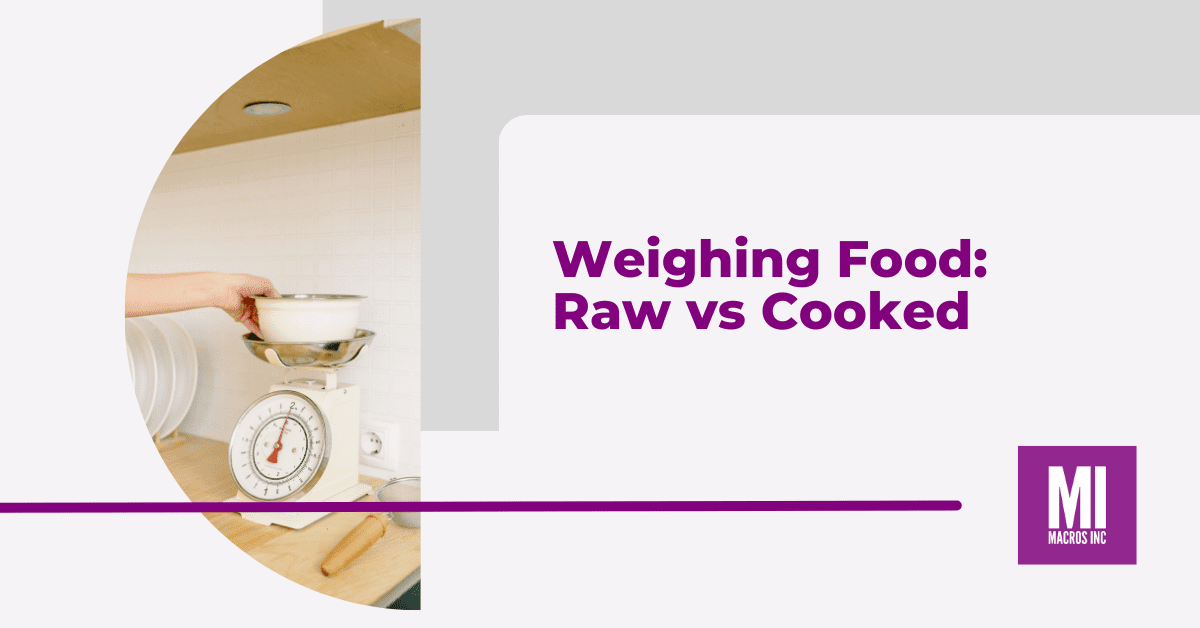Introduction
Weighing food can require a bit of a learning curve, we get that, so we want to help make it as easy as possible. One of the biggest road blocks for most people is whether they should weigh food raw vs cooked. This NutriWiki will give you the skinny on this conundrum.
Summary
- Tracked food should be weighed in its raw, unprepared state unless stated otherwise on the package.
- Food can be tracked cooked, but it reduces accuracy.
- The degree of inaccuracy with using cooked food varies.

Discussion
Weighing is the most accurate way to determine calorie and macronutrient content of a food. However, we are commonly asked whether food should be weighed raw or cooked.
The best answer is raw. Let’s talk about why, using steak as an example.
People like their steaks cooked different ways. However, the amount of cooking generally doesn’t change the calorie or nutrient content of the meat itself; two steaks of the same weight will have roughly the same nutrient profile, even if one is left raw and the other is cooked well done.
However, anyone who has cooked meat before knows that it loses juices as you cook it. How much is lost depends on the cooking method and how long it’s cooked for, but it’s safe to assume all forms of cooking cause the meat to lose at least some moisture. Note that what’s leaving the steak is mostly water – although some fat and such cooks out, the majority of the macronutrients remain intact. In other words, the macros will not change.
This is the main reason why raw is the most accurate method. No matter how the meat is cooked, or how much its weight changes, we know the macros are going to be the same. Conversely, if we are given a piece of cooked meat, we have no sure way of knowing how much it weighed when it started, so we can’t accurately state its calorie or macro content.
The amount of error this adds to your tracking varies, but can accumulate considerably over the span of several cooked meals. While this may not make or break one’s calorie deficit, it can certainly be a contributing factor if not accounted for.
Overall, having to guess at the macros of a cooked food every now and again isn’t likely to be an issue. It would be wise to limit it whenever possible in order to be as consistent and accurate as possible, though.
One exception to this rule regards packaged food which lists the nutrition facts in its cooked state. While this is less common than listing them unprepared, in these cases, the cooked values should be used.
Example
Let’s take a 225g (approx 1/2lb) cut of tenderloin steak, boneless, and trimmed to 0″ fat. Its macronutrient breakdown is as follows[1]:
320 kcal
49.5g protein
13.5g fat
0g carbohydrate
Now, say we cook that steak until about 50g of water leaves it. If we give it to someone and ask them to estimate the calories and macros of it, they have no idea how much water cooked out of it. If they assumed the raw values at the new weight, it would like like this:
250 kcal
38.6g protein
10.5g fat
0g carbohydrate
While 70 calories in of itself isn’t a night and day difference, these inaccuracies can add up to hundreds of missed calories in a week or even a given day. Those additional calories can certainly cause slower fat loss than expected.

